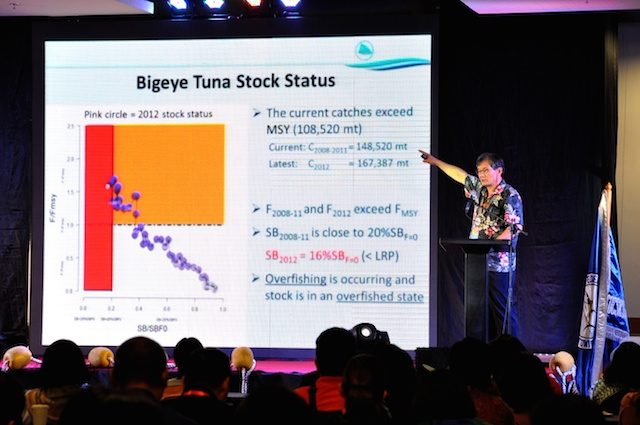SUMMARY
This is AI generated summarization, which may have errors. For context, always refer to the full article.

GENERAL SANTOS CITY, Philippines – The science manager of the world’s foremost tuna fishing organization said the Philippines is one of the member-countries of the Western and Central Pacific Fisheries Convention (WCPFC) that is relatively compliant with the conservation measures imposed by the tuna governing body.
Dr Sung Kwon Soh, science manager of WCPFC, made this observation during his speech at the conclusion of the 16th National Tuna Congress in General Santos City on Friday, September 5.
Bureau of Fisheries and Aquatic Resources deputy director Benjamin Tabios said in the last 3 years, the WCPFC has only issued one red alert to the Philippines.
The Philippines is ranked 7th among the tuna producing countries in the world. Most of its tuna catch are skipjacks, yellowfin tuna and small tuna species like frigate and bullet tunas.
The Philippines is the only member-country of WCPFC exempted from the ban on FAD (fish aggregating device) fishing in Pocket 1 High Seas that was closed to purse seine tuna fishing beginning 2011.
Soh spoke on the latest stock assessment of tuna species in the western and central Pacific Ocean.
He said the rapid decline of bigeye tuna stocks can be blamed on overfishing using long line and super purse seine fishing methods.
A majority of the country’s 167 tuna catching vessels are purse seine with less than 200-ton capacities.
The Philippines’ annual tuna catch exceeds 400,000 metric tons.
General Santos is the country’s biggest tuna producer with more than 167,000 metric tons of landings at the Philippine Fishport Development Authority (PFDA) complex here in 2013.
Although last year’s tuna catch was the highest in 5 years, industry leaders here admitted that tuna production has declined compared to 20 years ago.
In his welcome address at the opening of the Tuna Congress, General Santos City Mayor Ronnel Rivera conceded that the city’s annual tuna production has declined. (READ: Gensan looks beyond tuna)
“We have come to terms that we now have to make a move to arrest the steady decline of tuna stocks in our oceans,” he told some 500 delegates to the Tuna Congress.
He called on WCPFC member-countries to “share efforts, time, resources and responsibilities in finding solutions to this globally threatening trend.”
The Riveras are the country’s second biggest fishing company, with operations in Papua New Guinea and Indonesia.
Yellowfin tuna stock
Soh earlier said that while the biomasses of yellowfin tuna and skipjack have dropped, they remain healthy.
“Overfishing is not occurring in the yellowfin. The resources are still healthy,” Soh said.
The WCPFC scientist said yellowfin tuna stock will stay healthy in the next 20 years if current fishing operations are maintained.
The same holds true for skipjacks, although he said the WCPFC is trying to set a higher reference point for maximum sustainable yield (MSY) at between 40% to 60%.

But Soh said bigeye tunas remain at a critical level.
He said the WCPFC is pushing for a 36% reduction of ‘fishing mortality’ of bigeye tuna in order to recover stocks at sustainable level.
Philippine tuna purse seine operations are largely concentrated in catching skipjacks and other smaller tuna specie for the country’s 7 tuna canning plants.
Six of these tuna canning plants are in General Santos City.
Large yellowfin tuna catches are almost exclusively caught through handline fishing.
World conservationists have been complaining against super seine operators who said indiscriminate bigeye tuna fishing has resulted in the depletion of juvenile stocks that are by-catches of their operations.
Soh mentioned Asian tuna fishing operators from Japan, Korea and Chinese-Taipei.
WCPFC executive director Glenn Hurry earlier disclosed that bigeye tuna spawning biomass is now down to mere 3%. – Rappler.com
Add a comment
How does this make you feel?
There are no comments yet. Add your comment to start the conversation.